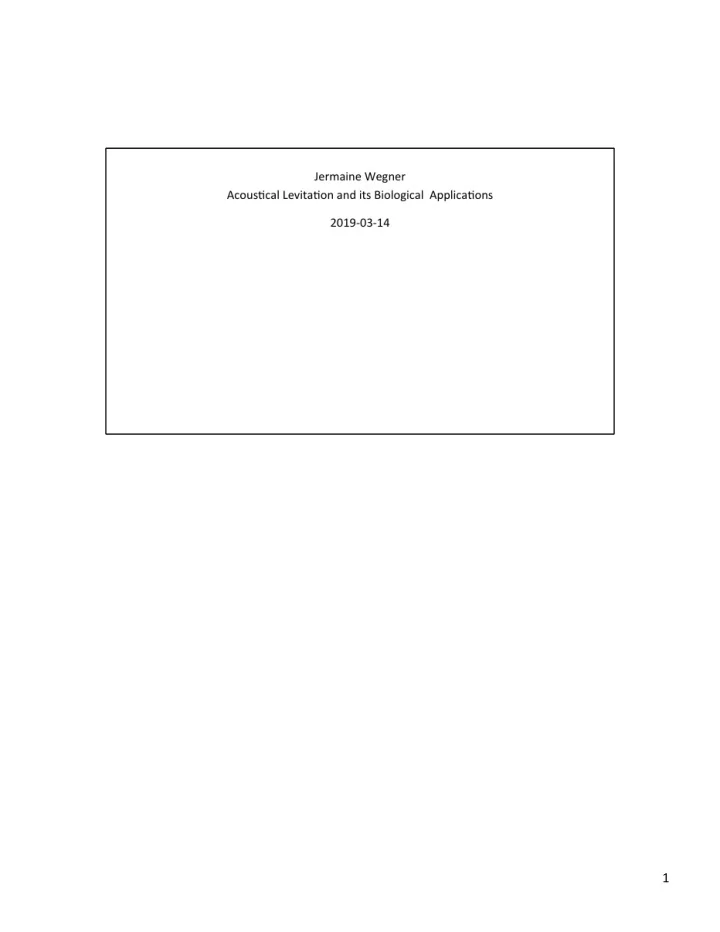

1
Give some examples of Sounds in everyday life. -Speech -Ultrasound machine used to break up kidney stones or destroy tumors -Ultrasound pregnancy -feel a sonic boom 2
::When the boundary of a Wave are fixed, there will be a transmiDed wave, as well as a reflected wave. When these two waves interfere with one another They give rise to what is known as a standing wave. They can also be thought of as a wave which oscillates with respect to Gme, yet has a peak amplitude that does not move in space ::Nodes 3
! ::When the boundary of a Wave are xfixed, there will be a transmiDed wave, as well as a reflected wave. When these two waves interfere with one another Thuey give rise to what is known as a standing wave. They can also be thought of as a wave which oscillates with respect to Gmxe, yet has a peak amplitude that does not move in space u ::Nodes It is well known that objects, all things being equal, will move from ;an area of high pressure to low pressure. :: well that’s essenGally what is the core of acousGcal levaGaGon . ; Varying the shape of the transducervoltage waveform had a significant effect on layer thickneuss, with a square waveform creaGngu thinner, more disGnct lauyers than a sine waveform due to steeper pressure gradients at the nodes. AcousGc levitaGon is a phenomenxon whereby pressuure differexnces of staGxonary sound waves can be used to suspend sxmall objects in gases or fluids such as air or water 4
An interesGng autobiographical note: I don’t know about anyone else, as for me, I notoriously had a difficult Gme visualizing standing waves. 5
6
::When the boundary of a Wave are fixed, there will be a transmiDed wave, as well as a reflected wave. When these two waves interfere with one another They give rise to what is known as a standing wave. They can also be thought of as a wave which oscillates with respect to Gme, yet has a peak amplitude that does not move in space ::Nodes 7
Cytoskeleton: essenGally a Gssue that connects a complex network of linking protein filaments, it brings to mind the image what most of us are familiar with. Cultures of Cells obviously extracted from the subject. Then the user sends a low-frequency sound wave through the fluid, at the respecGve acousGcal levitaGon frequency(250 kHz, and once the cells are levitated into a stable posiGon ,another ultrasonic wave can be emiDed, and essenGally an “ultrasound” can be taken , well you may ask, well jermaine, how is this important. Well it would allow us to study the cells in an environment more similar to one in vivo (one that would take place within the organism ) , also different densiGes react to ultrasound differently, what group of cells Ultrasonic signals from these cultures can be problemaGc due to the interference of reflecGons from the culture-plate well. The cell structure is also o`en deformed from its naGve state due to adhesion to the culture plate. 8
Human embryonic kidney cells (HEK) 9
Achieving diameters between 9 -15 microns 10
::When the boundary of a Wave are fixed, there will be a transmiDed wave, as well as a reflected wave. When these two waves interfere with one another They give rise to what is known as a standing wave. They can also be thought of as a wave which oscillates with respect to Gme, yet has a peak amplitude that does not move in space ::Nodes 11
A`er the acousGc levitator is adjusted to a proper state, we uGlize a tweezer carefully to introduce the animals into the levitaGon posiGon. Figure 1 shows the levitaGon process of an ant, a ladybug, and a young fish in air. Since the longitudinal component of the acousGc radiaGon force Fz is much larger than the lateral components Fr , these animals are usually levitated with the largest cross secGon of their bodies perpendicular to the reflector-emiDer axis, so as to stabilize their posture. The ant is usually levitated with a posture as if it is “crawling” in the air Fig. 1a. SomeGmes, it struggled to escape from the constraint of acousGc radiaGon force by rapidly flexing its legs Fig. 1b. However, it failed because its legs can obtain liDle counterforce from the air. The posture of the levitated ladybug is similar to that when it stands or crawls on the ground Fig. 1c. We can also place the ladybug into the levitaGon posiGon with its back downward and belly upward. In this case, the ladybug can hardly turn its body over by itself. Like the ant, the ladybug aDempted to escape from the levitaGon force too. It 12
13
14
15
16
17
18
Physicists at the Argonne NaGonal Laboratory are using sound waves to levitate individual droplets of soluGon containing pharmaceuGcals to improve drug development. Drugs fall into 2 categories: Amorphous and crystalline. Amorphous drugs are more efficiently absorbed by the body than their crystalline cousins due to their higher solubility which implies that a lower dose can be used. When soluGon are evaporated in a vessel, they are much more likely to solidify in a crystalline form. Thus to prevent this from happening, the soluGon need to be evaporated without touching any surfaces. This is where AcousGc levitaGon comes in. AcousGc levitaGon is used to evaporate soluGons without allowing them to crystallize. 19
this is more of a bonus feature than the actual presentaGon, but I don’t want to not give credit. 20
Recommend
More recommend